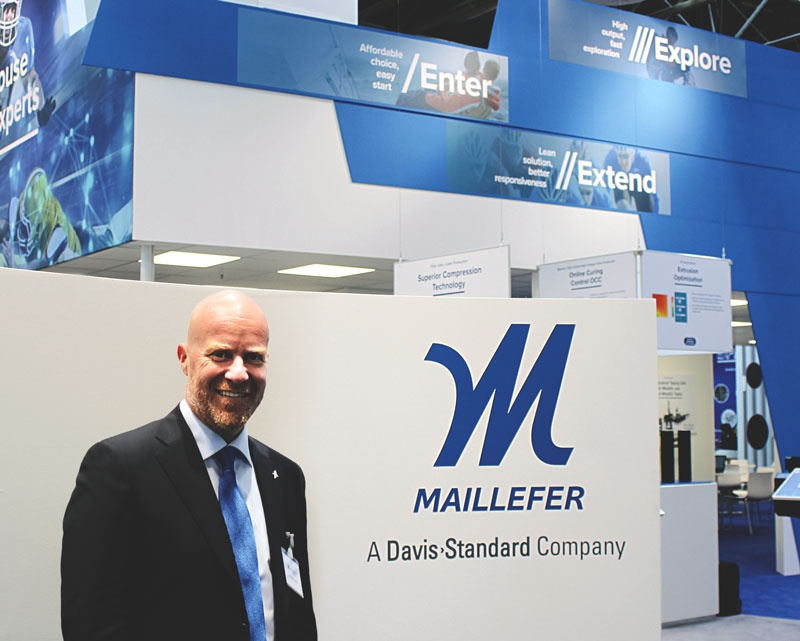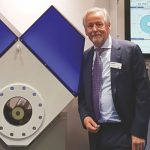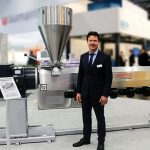Maillefer’s cable making lines and solutions extensively use Industry 4.0 parameters to churn out some of the most intelligent and efficient production systems. Its solutions with built in data measuring devices and software have improved the cable production significantly with increased production run, cable length, line speed and cable geometrical quality.

Wire & Cable India talked to Dr. Mikko Lahti, Director, R&D, Maillefer Group to know how company is using the concept of automation and digitization a big way in fabricating world-class machinery. Here are the excerpts:
Wire & Cable India: As you are heading the R&D unit at Maillefer, can you tell us how you go about in considering a trend worth researching?
Mikko Lahti: At present, the trend such as Industry 4.0 is causing a great upswell of interest in industries across spectrum and is a big driving force for us as well. Industry 4.0 is essentially the automation of manufacturing technologies with built in data collection and exchange mechanisms. Data today is a great power – to closely monitor and control operations. Therefore, in most of the cases, data collection has become important for the people. However, mere data collection is of no use unless it is analyzed to troubleshoot and upgrade the technology. Even though the industry has the data for decades, its convincing use has still not begun. Maillefer’s R&D has been absolutely dedicated to how to measure, analyze, understand, and act. We are measuring a huge pile of data in the products lines that we are offering.
We know what data should be measured and what devices should be used in our lines and machines. The devices help us to analyze the data and take decisions in terms of controlling our actions. Suppose we are drawing a line, the data can help us learn if we should draw a line in a particular way or not. This utilization of data immensely helps us in our R&D with regard to designing a perfect machine. Designing and manufacturing machines are basically what we do, but once we have analyzed previous data we can envision better machines – more efficient extruders and crossheads. The deeper knowledge of process is also critical in order to better utilize the data in order to get a conclusive idea of how the machines have been working previously and how we can optimize it more. Hence, the acute data measurement and analysis coupled with extensive process knowledge is the key to the success of our R&D.
WCI: Does your R&D help you get an edge over other technology providers?
ML: Considering our long history of developing technology for the wire and cable industry, I would say we have gained immense knowledge of the processes. We can process ample data at any given time and it enables us to develop more efficient lines. The data collection, its analysis, and implementation are what help us constantly improve our lines and get an edge over competitors.
WCI: Are there new developments on product front, especially on cable side?
ML: We have developed a new measurement device called topography scanner, which offers a way to continuously monitor extrusion quality, find an optimal set of parameters, and increase CV line productivity. Another notable aspect of this device is the ability to scan the whole cable core surface during production. If there are any defects visible on the cable core surface, they are detected and immediately reported to the operator.
On the cable side, we are constantly working to improve the cable lengths by reducing the number of factory joints in the submarine cable production and also minimizing the CV line insulation process down time. We have proven in several actual cable production runs that you can run continuously more than 100 tons of insulation compound in a CV line. Maillefer has also developed new extruders and crossheads that are helping customers to run longer lengths. Moreover, customers can improve the cable production at our R&D Center, where vertical pilot line makes it possible to produce model cables at an unmatched pace. This spring we conducted a joint development effort for the optimization of process conditions for our customer’s VCV line producing high voltage cables. They faced sizable challenges with a new cable construction.
The fiber optic cable demands more line efficiency as the speeds have become higher than ever before. We have to play a lot with the optic fiber solutions to improve the efficiency. No wonder we are providing state-of-the-art lines with immense speeds today, but it is not just the speed that matters. There are many perspectives to consider when optimizing the production of a cable factory, of which the secondary coating process is a crucial part. In this case, the effort focused on finding the right balance among factors such as production length, production time, line speed, and cable geometrical quality. We have put in immense efforts for minimizing chances of the machine downtime. We have created a virtual pilot line, where we can see the working and the efficiency of the whole line with the help of simulation.
WCI: Do you agree that investing in a good technology can actually lead to a desirable payback for cable companies?
ML: The equipment’s efficiency is the most crucial factor as far as a manufacturing activity is concerned. There are times when our customers are interested more in knowing the outcome of a solution that we provide than the initial investment. We basically want our solution to prove cheaper for the customers in the long run and it has turned out to be true with our existing customers, who are getting a definite payback.
Despite the positive implications of our solutions in the long run, pricing often comes as a difficult topic to discuss with the Indian clients. We are always more than ready to prove how our solutions would prove cost-effective with quality yield over a long period. However, they still prefer the Chinese version of our lines that run at one-third speed with frequent downtimes and poor quality output. Cable-makers are lured by the lower prices.
WCI: You are now a part of Davis Standard. How is Maillefer availing benefit especially in the R&D sector because of this merger?
ML: It is seldom when you can discuss business with real experts, for instance, subjects such as extrusion. In extrusion, only few players are doing original work, which is deep and innovative, and Davis Standard is one of them, who has this knack of churning out cutting-edge extrusion solutions. These people are now with us. The discussions with the company are quite fruitful for us. Earlier when Davis was our competitor, we used to wonder how they are able to make a particular solution so differently. They have mastered so many useful solutions in many areas of material processing, especially in extrusion. Both Davis Standard and Maillefer have very few overlapping areas or applications. It is therefore not difficult to fine tune our existing portfolio.
WCI: What are your views in general for the cable industry?
ML: At this point of time, it is very bright. If we take an example of the power cable manufacturing, Europe and China have been investing heavily in the sector. I have been in this business for more than 20 years and India has always been on a stage of procrastinating things to next year. Though India has begun investing more on technology side, it is a difficult market for us. We however plan to serve the Indian market on long-term basis.




